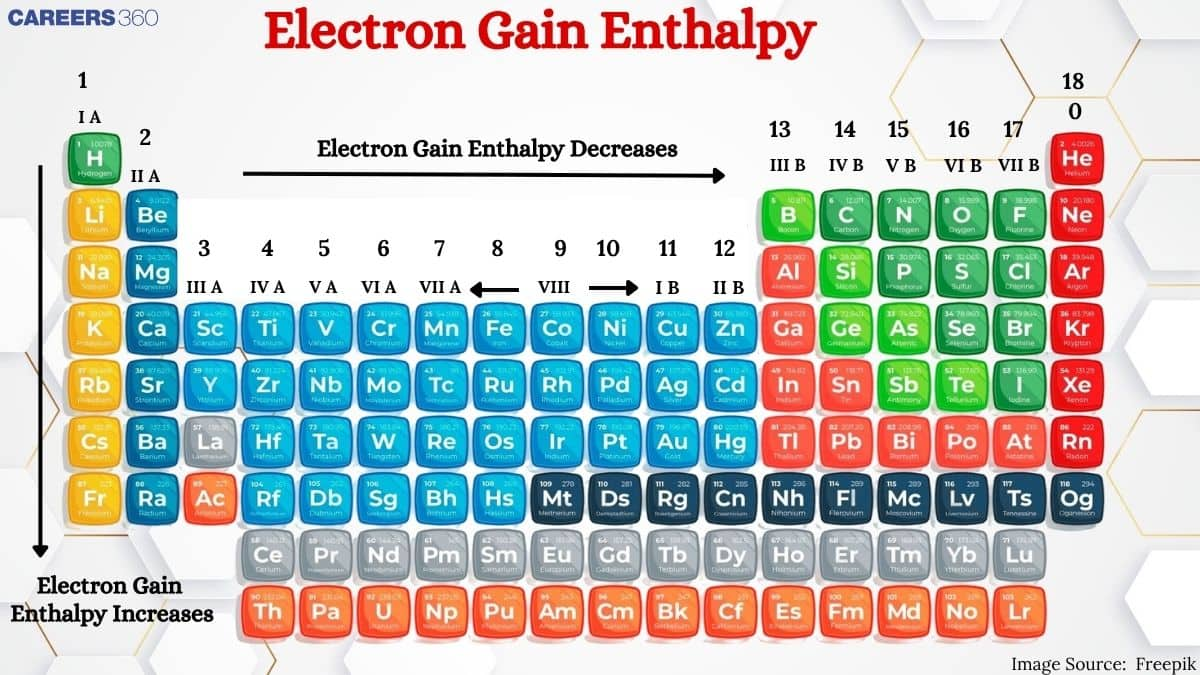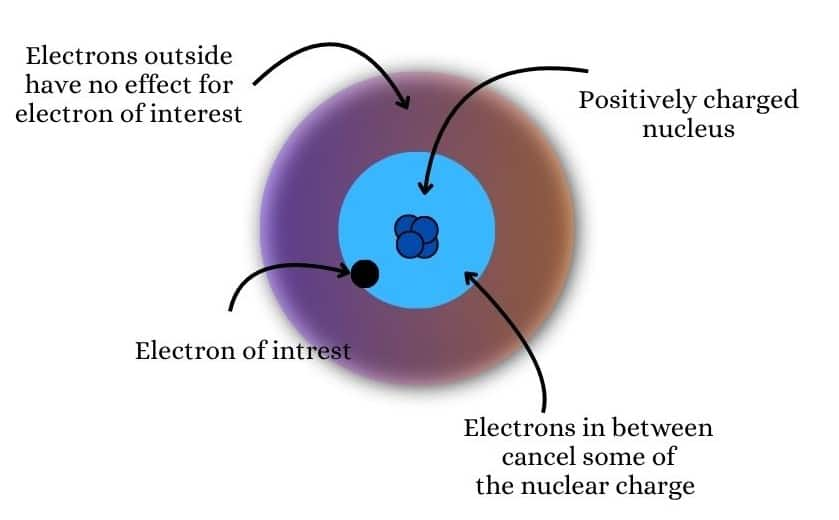Electron Gain Enthalpy - Meaning, Definition, Differences, Factors, FAQs
Electron gain enthalpy is the change in energy when an atom or molecule takes up an electron to produce a negatively charged ion. Electron gain enthalpy indicates an element’s ability to accept an additional electron as stated by the energy released or absorbed during an electron gain.
This Story also Contains
- Electron Gain Enthalpy Of Elements
- Electron Gain Enthalpy Table
- Variation of Electron Gain Enthalpy
- Solved Examples Based on- Electron Gain Enthalpy

In this article, we will be focussing on the in-depth knowledge of the important topic of electron gain enthalpy, which is the sub-topic of the chapter Classification Of Elements And Periodic table from class 11 chemistry. It is not only essential for board exams but also for competitive exams like the JEE Mains Exam, NEET Exam, and other entrance exams such as SRMJEE, BITSAT, WBJEE, BCECE, and more.
Electron Gain Enthalpy Of Elements
Studying electron gain enthalpy reveals the nature of elements’ dealing with electrons, their ability to accept or give away electrons determines their chemical activity. Atoms with low electron affinity lose energy when taking the extra electrons and the more energy is lost the better of forming negative ions. It is vital in explaining trends of periodicity and in making estimations of other chemical reactions in all branches of chemistry.

Electron Gain Enthalpy (ΔegH)
Electron gain enthalpy is the energy change that occurs when an electron is added to a neutral gaseous atom to form a negative ion. It is also known as electron affinity. f13
A(g)+e→A−(g)+Δeg H
Factors affecting electron gain enthalpy
The electron gain enthalpy or electron affinity depends upon various factors such as:
Atomic Size
With the increase of atomic size, the distance between the nucleus and the last shell electrons also increases due to which the force of attraction between the nucleus and the incoming electron decreases. Hence, the electron gain enthalpy becomes less negative.
Nuclear Charge
With the increase of nuclear charge, the force of attraction between the nucleus and the incoming electron increases. Thus, the electron gain enthalpy becomes more negative.
Electronic Configuration
Elements that have half-filled or filled orbitals are more stable than others. In these cases Generally, energy has to be provided to add an electron. Thus, their electron gain enthalpy generally has large positive values.
Also Read:
Electron Gain Enthalpy Table

Variation of Electron Gain Enthalpy
The electron gain enthalpy becomes less negative in going from top to bottom in a group.
In moving from top to bottom in a group, both the atomic size and the nuclear charge increase. However, the effect of the increase in atomic size is more dominant than the nuclear charge.
With the increase in atomic size, the attraction of the nucleus for the incoming electron decreases. Hence, the electron gain enthalpy becomes less negative. But in moving from left to right in a period, the attraction of the nucleus and the incoming electron increases, and thus electron gain enthalpy becomes more negative.
Halogens have the most negative electron gain enthalpies. In moving down from chlorine to iodine, the electron gain enthalpies become less negative due to the increase in their atomic radii.
Chlorine has the most negative electron gain enthalpy value than fluorine. Because fluorine is very small in size due to which there is a very strong inter-electronic repulsion for the incoming electron, thus its electron gain enthalpy is less than chlorine.
Generally, Members of the 2nd period in p-block elements show the anomalous value of electron gain enthalpy.
Related Topics link
- Electronic Configuration of First 30 Elements
- Homologous Series
- Atomic radius in the periodic table in basic chemistry
- Classification of Elements in Modern Periodic Table
Recommended video based on (Electron Gain Enthalpy)
Solved Examples Based on- Electron Gain Enthalpy
Example 1: Electron affinity is the
1) Energy absorbed when an electron is added to an isolated atom in the gaseous state
2) Energy is released when an electron is added to an isolated atom in the gaseous state
3) The energy required to take out an electron from an isolated gaseous atom
4) The power of an atom to attract an electron to itself
Solution: As we have learned,
Electron affinity is the ability of any isolated gaseous atom to take up a free electron. Energy is released in the process of electron gain.
Hence, the answer is the option (2).
Example 2: The correct order of electron affinity is :
1) F > Cl > O
2) F > O > Cl
3) Cl > F > O
4) O > F > Cl
Solution: As we learned in
Variation of electron gain enthalpy in the periodic table -
- Electron gain enthalpy decreases down the group.
- generally, the electron gains enthalpy increases (more negative) along the period.
The correct order of electron affinity is Cl > F > O
Hence, the answer is an option (3).
Example 3: Which one of the following arrangements represents the correct order of electron gain enthalpy value (less negative) of the given atomic species?
1) S<O<Cl<F
2) O<S<F<Cl
3) Cl<F<S<O
4) O<S<Cl<F
Solution: As we learned
Variation of electron gain enthalpy with the size of an atom -
In general, the electron gain enthalpy value decreases (less negative) with increasing atomic radius.
- wherein
△egH−or E.A ∝ 1 /Atomic radius
Electron gain enthalpy decreases with increasing atomic radius.
Hence, the answer is the option (2).
Example 4: The electron gain enthalpy(in kJ/mol) of fluorine, chlorine, bromine, and iodine respectively are:
1) −333,−349,−325 and -296
2) −349,−333,−325 and -296
3) −296,−325−333, and -349
4) −333,−325−349 and -296
Solution: The electron gain enthalpy becomes less negative in going from top to bottom in a group.
Chlorine has the most negative electron gain enthalpy value than fluorine. Because fluorine is very small in size due to which there is a very strong inter-electronic repulsion for the incoming electron, thus its electron gain enthalpy is less than chlorine.
The electron gain enthalpy values are given below:
Fluorine = -333kJ/mol
Chlorine = -349kJ/mol
Bromine = -325kJ/mol
Iodine = -296kJ/mol
Hence, the answer is the option(1).
Example 5: In which of the following pairs, electron gain enthalpies of constituent elements are nearly identical?
(A) Rb and Cs
(B) Na and K
(C) Ar and Kr
(D) I and At
Choose the correct answer from the options given below :
1) (A) and (B) only
2) (B) and (C) only
3) (A) and (C) only
4) (C) and (D) only
Solution: From the given option -
(Rb and Cs) have nearly the same electron gain enthalpy, nearly -46 KJ/mol.
Whereas (Ar and Kr) have nearly the same electron gain enthalpy is +96KJ/mol.
Hence, the answer is the option (3).
Practice more Questions from the link given below:
Conclusion:
Electron gain enthalpy (ΔₑgH) measures the energy change when a gaseous atom gains an electron: negative if energy is released, positive if absorbed. I becomes more negative across a period, and less negative down a group, with notable exceptions like fluorine versus chlorine due to electronic repulsion. Highly negative values in halogens drive strong anion formation, while positive values in noble gases and stable configurations resist electron gain. This concept is crucial for predicting reactivity, guiding industrial processes (e.g., battery chemistry, water disinfection), and serves as a fundamental principle in competitive exams and materials design.
Also check-
- NCERT Exemplar Class 11th Chemistry Solutions
- NCERT Exemplar Class 12th Chemistry Solutions
- NCERT Exemplar Solutions for All Subjects
Frequently Asked Questions (FAQs)
Generally, electron gain enthalpy becomes more negative as you move from left to right across a period due to increasing nuclear charge, which attracts electrons more strongly. However, there are exceptions, particularly with noble gases and specific transition metals. As you move down a group, the electron gain enthalpy usually becomes less negative due to increased atomic radius and shielding effect.
The enthalpy change that occurs when a neutral gaseous atom accepts an extra electron to create an anion is known as electron gain enthalpy. It is a quantitative property and can be measured.
The tendency of an element's atom in a chemical compound to attract a shared pair of electrons towards it in a covalent bond is known as electronegativity. It is a qualitative property and hence is not measurable.
Chlorine has the highest electron gain enthalpy.
The factors influencing the electron gain enthalpy are :
Atomic size
Nuclear Charge
Electronic configuration
Electron gain enthalpy is measured experimentally by determining the energy change when an electron is added to a neutral atom in the gas phase. This can be done using calorimetry or other thermodynamic methods.
Noble gases typically have high (positive) electron gain enthalpy because they have complete valence electron shells and are energetically unfavored to gain an additional electron.
The electron affinity of phosphorus is 72 KJ/mol.